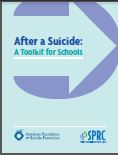One of the many disturbing aspects of youth suicide is the concern that they can be “contagious” in the sense that one suicide or suicide attempt increases the risk that others around them will follow suit.
A recent study that surveyed thousands of Canadian adolescents did indeed find that having a schoolmate that died by suicide or knowing someone personally who died by suicide was found to increase the personal risk of both suicide ideation  and attempts. Compared to respondents who reported no suicide exposure, those who did were five times as likely to report suicide ideation at age 12-13 and nearly three times as likely at age 14-15. There was also a three to fourfold risk of attempts among exposed youth at all age groups. For example, among 12-13 year olds, a total of 7.5% of children exposed to suicide reported their own attempt versus 1.7% of unexposed children. Personally knowing the schoolmate who died by suicide did not increase the risk. These effects were slightly increased with the presence of other stressful events but surprisingly, were not modified by levels of social support, own prior suicidality, depression, or anxiety. Furthermore, the effect was found to persist even years after the event.
and attempts. Compared to respondents who reported no suicide exposure, those who did were five times as likely to report suicide ideation at age 12-13 and nearly three times as likely at age 14-15. There was also a three to fourfold risk of attempts among exposed youth at all age groups. For example, among 12-13 year olds, a total of 7.5% of children exposed to suicide reported their own attempt versus 1.7% of unexposed children. Personally knowing the schoolmate who died by suicide did not increase the risk. These effects were slightly increased with the presence of other stressful events but surprisingly, were not modified by levels of social support, own prior suicidality, depression, or anxiety. Furthermore, the effect was found to persist even years after the event.
In the already tragic aftermath of a youth suicide, it can be extremely difficult to balance legitimate needs for community expression and support with efforts to try and limit any possible contagion effects. However challenging, this study informs us that were are not off the hook for this important task.
The American Foundation for Suicide Prevention has developed a free, downloadable, and quite practical toolkit to guide schools and others on how to navigate this very tricky water following the suicide of an adolescent of not wanting to increase stigma for suicide and mental health conditions while also trying to minimize any possible contagion effects. Some of the main points include the following.
- Schools should have a crisis response plan for such an event that includes an appointed team leader who, in term, can rapidly put together a crisis team if needed
- Emphasizing that suicide is often the result of potentially treatable mental illness rather than a more romanticized story
- Trying to keep to regular school hours and dismissals
- Strong encouragement of the media to follow procedures that can reduce contagion
With school out of session, this could be a very good time to make sure we are all as prepared as possible for these mercifully rare but very troubling contingencies.
Reference
Swanson SA, Colman I. Associations between exposure to suicide and suicide outcomes in youth. Can Med Assoc Journal 2013; 185: 870-877.
Tags: copycat suicide, suicide, suicide contagion

